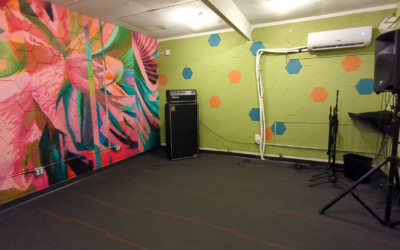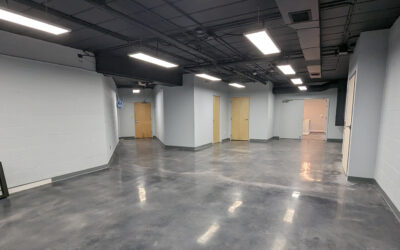

Photo courtesy of River Arts District Artists
The River Arts District Reckons with Sustainability
Booming development and rising rents are displacing the artists who call the RAD home – but the creative community is working together to ensure its future
April 10, 2024 | As part of our continuing series profiling pioneering creative spaces and the challenges faced by artists in Asheville and Buncombe County, we are highlighting the River Arts District (RAD). A draw for locals and an estimated 12.5 million visitors a year, the RAD counts almost 300 artists across 23 buildings and 2 square miles.
Amidst the unprecedented growth and popularity of the area, the RAD’s creative class, which helped define it, faces displacement due to rising rents and decreasing inventory for residential, studio, and work space. Many are leaning on creative collaborations to rise to the challenge, carrying the vision of the District’s founders forward for the next generation.
Steeped in History
The RAD, just west of downtown Asheville on the banks of the French Broad River, has undergone profound shifts. Initially an important space for Cherokee life and culture for thousands of years before the tribe’s forced displacement, the RAD subsequently became a center of industrial activity, as well as a site of urban renewal that destroyed over 1000 homes, seven churches, and over 60 businesses.
Beginning in the mid-1980s, the RAD revitalized the area to become a hub for artists – the origin of its current moniker. Highwater Clays founded the Studio Stroll in 1994, turning the stroll over to the River District Artists (now the River Arts District Artists, Inc., or RADA) in 1998. The area was officially named the River Arts District in 2005. Today, RADA includes over 300 artist members.
Throughout the late 2010s, the RADTIP (River Arts District Transportation Improvement Project) transformed the District yet again, restructuring roads and sidewalks. The $50 million project also added bike lanes, stormwater management improvements, wetland conservation areas, nine acres of parkland, and 200 parking spaces, and created connected greenways, part of the Wilma Dykeman Riverway Corridor, a networked recreational transportation system throughout the county. The greenway has brought new traffic, both on foot and vehicular, to the District.
Sustainable Development?
The horizon line of the RAD continues to evolve, with new constructions going up beside refurbished original structures. An Asheville Watchdog story reports that the value of several RAD buildings has increased 30 to 50 percent between 2017 and 2021. Rumors are also swirling that an Amtrak station connecting Asheville with points east could eventually be constructed in the District.
For RADA President Jeffrey Burroughs, “as an artist working in the River Arts District (RAD), experiencing its steady growth is both exhilarating and daunting. On one hand, the influx of visitors and attention has provided opportunities for exposure and recognition for many artists. On the other hand, there’s a palpable sense of concern among artists about being priced out and the impact of gentrification on the community’s essence.”
As property values and rents continue to rise, “many longtime artists fear they’ll be forced to leave, and some already have,” continues Burroughs. “This erodes the very soul of our district. The unique character and authenticity that drew people here in the first place are at risk of being diluted.”
The most recent addition to the landscape of the RAD? The Radical, a 70-room boutique hotel. Owned by developer Hatteras Sky, which also purchased the Phil Mechanic Building next door, the 1920s-era building did once house several artist studios, but was in dire need of repairs. The Phil Mechanic fared better, and Hatteras Sky plans to keep the majority of the building devoted to the arts (though it also plans to add some office spaces). Burroughs notes that the developers of the hotel and other buildings, including 375 Depot Street, “have been working very closely and fostering relationships with our community,” including supporting the arts through RADA’s Corporate Sponsorship program.
The River Arts Apartments, which are going up now at the corner of Clingman Ext. and Roberts St, will have up to 245 residential units, up to 20,000 square feet of retail space, an open plaza, and a parking deck, according to an Ashvegas report in 2022. Construction of the apartments has affected accessibility in the district, resulting in partially closed throughways and blocked sidewalks, and hindering traffic to nearby businesses.
“The District is getting more populated,” says Libby O’Bryan, founder and owner of Sew Co. (240 Clingman Ave. Ext.) and Rite of Passage Clothing. O’Bryan, who has been in Asheville for almost two decades, opened Sew Co., a creative design studio and urban sewing factory, two and a half years ago. While she supports sustainable development in the area, especially when it uses pre-existing urban space and infill, “Roberts St. and our part of Clingman have seen a lot of dysfunction” since construction began on the River Arts Apartments last July. “It’s affected both general traffic and foot traffic,” she explains. “It’s dirty and not as welcoming.”
She has combatted fewer visitors and slower sales through her online store, as well as special events, including holiday pop-ups.
For as many new projects that break ground, there are a handful that have yet to progress. In 2017, Asheville City Council approved construction of the Stoneyard Apartments, 133 units in four buildings that would also include a restaurant, 10 artist studios, and a parking structure. No progress has been made on construction, which Asheville Citizen-Times reported was stalled by the pandemic.
Rising costs also continue to price out artists who have worked in the area for years. At the end of 2022, Magnetic Theatre closed its physical space on Depot St. after several years of financial turmoil. The company is working to take its shows to other local venues.
The Way Forward
In 2017, Artspace, working with the Center for Craft and the Asheville Area Chamber of Commerce, identified the city-owned property at the site of the former Ice House (81-91 Riverside Dr.) as a potential spot for 80 affordable housing units for artists. There has been no official plan released for the property’s development.
Burroughs cites affordable housing as key for “finding a balance between growth and preservation. Implementing affordable housing programs specifically tailored to artists and creatives can help ensure that they can continue to live and work in the district despite rising rents and property values,” they say. “This could include incentives for developers to include affordable housing units in new developments or subsidies for artists to access affordable housing.” They also point to a need for zoning, a commitment to preservation, and a future focus on creative placemaking to ensure the character of many of the area’s artistic spaces and cultural institutions.
Individual artists and smaller arts organizations can also have an impact. Burroughs notes that some organizations are finding creative solutions to combat affordability issues. Some, including Trackside Studios, Marquee, and Art Garden, have committed to keeping rent affordable by representing many artists. Others, including Philip DeAngelo Art, have shifted some or all of their studio space into gallery and retail space.
For O’Bryan, the decision to separate studio and retail or gallery space opens up bigger questions about the future of working artists in the RAD. “How do we grow and develop, which is inevitable, but still maintain the culture of working artists in these spaces?” she asks. “Having a connection to the artists who are making the things you’re buying deepens the worth of the things we own. I worry about what will happen if that can’t continue. There has to be an economic solution.” She points to RADA and RADBA (the River Arts District Business Association) as community players “that can really uphold the values of this neighborhood for the greater community through economic development specifically.”
“I am a true optimist, and having that perspective leads me to be excited about how change, even when it’s difficult, can bring a community of people together,” Burroughs says. “In the short time I’ve been here, I’ve seen the strength of our artistic community, and their willingness to step up and work together, not only as artists, but as a coalition, a body of voices taking hold of what we need to do now to ensure our future – and the future of those who come after us.”
RADA’s vision for the area depends on artists and patrons of the arts showing up to city meetings to ensure that the community has a voice, and eventually artists, businesses, and city officials working together to ensure the community thrives, all while building upon “the foundation and groundwork from the artists that began the journey decades ago,” Burroughs says.
ArtsAVL has been working to support RAD’s creative economy, and to make it even more accessible to locals and visitors, through advocacy initiatives like the Creative Spaces report and the ArtsAVL Trolley. The free trolley, which runs every Second Saturday, spans two interconnected routes in downtown and the RAD. Riders can hop on and off at any stop to explore, eat, drink, and shop. In its first six months of operation, the trolley hosted over 1,300 riders. 92.5% of businesses reported being satisfied or very satisfied with the trolley, and 81.5% reported a positive impact on their businesses.
Stay tuned for more profiles of creative spaces, and for ArtsAVL’s Creative Spaces Report, which will assess the local creative landscape to provide crucial information for understanding the current reality and possible paths forward for the creative community. Visit artsavl.org/spaces for project updates and register for the upcoming Town Hall (May 10).
Related Articles
RadHaus Studios Brings Affordability and Aesthetics to Rehearsing and Recording
Rock Pyle rehearsal space, mural by Kathryn Crawford | Courtesy of RadHaus Studios RadHaus Studios...
Asheville Community Theatre Opens Up to Possibility
Photo of Partially Completed Renovation, Courtesy of Asheville Community Theatre Asheville...
Black Mountain’s Collaborative Creatives
Photo courtesy of White Horse Black Mountain Black Mountain’s Collaborative Creatives In the town...



